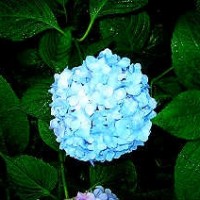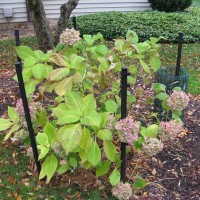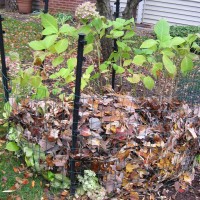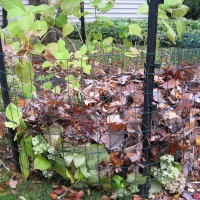 Hydrangeas can be confusing at nearly every season. Fall confusion produces as many questions as spring confusion.
Hydrangeas can be confusing at nearly every season. Fall confusion produces as many questions as spring confusion.
In the fall, people in the northern United States look at their hydrangeas and wonder, “Now what?”
Winter is coming.
Do I cut my hydrangeas back?
Do I let them go just as they are?
Everyone has advice. I’ll offer you mine and also point you to some really excellent web sites on hydrangeas (look for the links).
Most of the confusion can be resolved by knowing which hydrangea you have and where you live (check this hardiness zone map). One web site that has a nice, easy-to-understand description has a Hydrangea Identification page. It will help you to discern whether or not yours is:
- a big leaf (H. macrophylla, also called Mophead or Lace Cap) which is commonly offered in various blue and pink forms and often can be color changed by altering soil pH.
- oakleaf (H. quercifolia) which is native to the southeastern US,
- Peegee (H. paniculata) which is native to Japan/China and has flowers that are elongated panicles rather than rounded, or
- “Annabelle’ type (H. arborescens) which have the large white ball-like flowers. ‘Annabelle’ is the most famous of this class of hydrangea.
You’ll notice I listed them all as H. (which stands for Hydrangea) and then a different name second. That’s because like a family all has the same last name and your first name distinguishes who in your family is being discussed, so the Latin second name refers to a specific species within a genus (the name Hydrangea). How you care for hydrangeas depends on how hardy yours is and whether it characteristically blooms on old wood (last year’s growth) or new wood (current year’s growth). In any case, I stop all fertilizing of hydrangeas and roses after August 15th to convince these plants to enter dormancy.
Among the ones that bloom on new wood are Endless Summer, H. paniculata such as Limelight, and H. arborescens “Annabelle”. Because these bloom on new wood, the current season’s growth, they can be pruned at any time, although late fall (after a few hard frosts) ensures they won’t try to continue putting out new growth and instead will enter dormancy. Endless Summer will produce better/ more profuse blossoms if the spent flowers are removed. If your Endless Summer are still smaller in size, you can just let them go through the winter, no pruning needed at all. If yours are larger, you can prune them back, but it’s not necessary. The grower has a nice winter care guide. “Annabelle” is prized for its large white blossoms, but it can be cut down severely in the fall which helps it to maintain a better shape and sturdier habit for the following year (unless you prefer your Annabelle flowers bent over into your mulch, but frankly she deserves better than facedown in the dirt).
Old wood: most of the other macrophylla (big leaf) and quercifolia (oak leaf) types must be pruned immediately after flowering as by fall, they’ve set their flower buds. Lilacs, azaleas, rhododendrons, and many viburnums do the same thing. Pruning these in the fall will cut off all the flower buds. So how do I overwinter my macrophylla “Nikko Blue” and some so-called Color Change that aren’t actually hardy in my area? I bought all of these knowing that they are marginally hardy and would die back down to their roots in Chicagoland. I brought back my “Nikko Blue” from New Jersey many years ago as a sentimental family favorite and my “Color Change” were a carryover from some pots I’d planted at church. I couldn’t bear to throw them out when I switched the pots to mums and winter evergreens and decided to give these hydrangeas a whirl in my garden. The first year in the ground neither of these bloomed because they died too far back in the winter. While hydrangea foliage is attractive enough, it misses the whole point of the beauty of the flowers! I learned my lesson so now…
This is how I overwinter my marginally hardy macrophyllas:

Step 1: I stake the area around my hydgrangea while the ground is not frozen (left). But covering hydrangeas before they go dormant doesn’t help them. Make sure that there have been a few hard frosts before continuing.
Step 2: I surround my plant with rabbit fencing to create a corral (right) and begin to place the last of the fall leaves around the base of the plant as we get hard frosts.
Step 3: I slowly and gently pile leaves from the center out to the tips of the plant to bend the stalks without breaking them (left).
Eventually the entire plant will be covered with a layer of leaves and I put some netting over the top to keep the leaves from blowing away during the winter. Of course, this makes a mess for removal in the early spring time after the coldest of winter days have passed. I remove the stakes, unwind the corral, and then the leaves used as cover slide easily from the center outward. The leaves may be slimy and partly decomposed, but they’ve served their function of blanketing the stalks through the coldest winter days.
While this method has worked beautifully to have abundant flower buds survive a Chicagoland winter, it’s important to note that I remove the leaves before the buds “break” (start to unfurl) so that the leaves don’t rot and so the buds don’t send out tender new growth to get zapped by late frosts. I keep my eyes on the forecast because after uncovering the bud-filled branches, I may need to cover them with frost cloth if we are due to dip below their hardiness. Once the leaves are removed, the buds will need to adjust to the unsheltered conditions…just as they would in areas of the country where they are fully hardy.
In the spring, after I see where the strongest growth is maintained and where the deformed (damaged) buds begin, I prune the stalk into the strong growth section. This ensures that I will have the maximum number of flower buds, but not have the tips stunted by damaged growth. It may seem like a lot of work to go through, but the reward is well worth it if you’re trying to grow certain macrophylla hydrangeas at the northern end of their hardiness.
The newer macrophylla varieties like Endless Summer have achieved great popularity because they have all the benefits of the beauty of the big leaf varieties without the hassle of overwintering. They’re well worth the price in both beauty and hardiness. But now, at least, you have an option to try if you’re trying to grow macrophyllas north of their normal hardiness.

